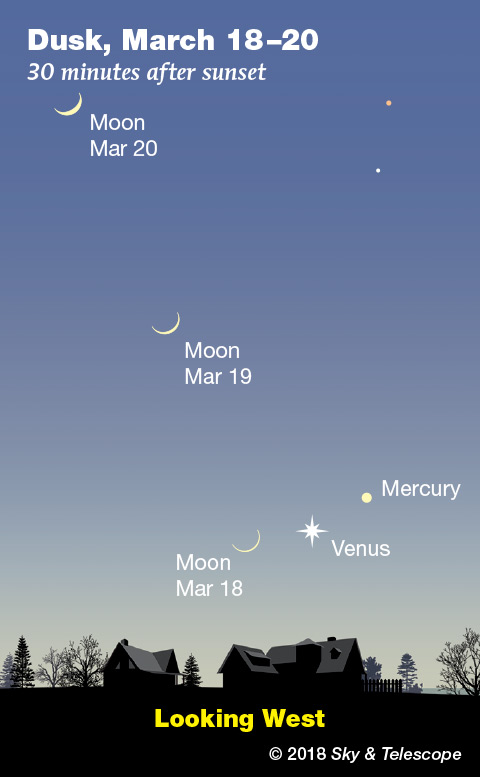
Friday, March 16
• The biggest asterism in the sky is the Winter Hexagon. Right after dark in March, it fills the sky toward the south and west. Start with brilliant Sirius in its bottom, nearly south. Going clockwise from there, march upper left through Procyon, then up to Pollux and Castor near the zenith. Then head far to the right through Menkalinan to bright Capella, then lower left to Aldebaran, farther lower left to Rigel in Orion's foot, and back to Sirius.
Betelgeuse shines inside the Hexagon, below center.
In a few weeks, as the constellations wheel westward and the Hexagon's lower half sets, its top half becomes the twilight Arch of Spring.
Saturday, March 17
• Spring begins in three days — so watch the low east-northeast tonight for the rise of the "Spring Star," Arcturus. Find the Big Dipper high in the northeast and follow the curve of its handle down around, by a little more than a Dipper-length, to see where Arcturus is — or soon will be.
• New Moon (exact at 9:12 a.m. EDT).
Sunday, March 18
• As twilight fades, look low due west for Venus with the super-thin Moon 3° or 4° to its left, as shown above. A similar distance upper right of the Moon, look for Mercury, much fainter at magnitude +0.4.
• By nightfall, the Big Dipper is high in the northeast and beginning to tip left. Look well to its left for Polaris and the dim Little Dipper. Other than Polaris, all you may see of the Little Dipper through light pollution is the two stars forming the outer edge of its bowl: Kochab (similar to Polaris in brightness) and below it, fainter Pherkad. Find these two "Guardians of the Pole" to Polaris's lower right by about a fist and a half at arm's length.
Now is the time of year when the Guardians line up exactly vertically at the end of twilight.
Monday, March 19
• If the crescent Moon were a bow, it would shoot an arrow to the lower right just past Venus in this evening's twilight, as shown above.
• After dark, Sirius shines brilliantly in the south-southwest. Lower left of Sirius, by about one fist, is the triangle of Adhara, Wezen, and Aludra, from right to left. They form Canis Major's hind foot, rear end, and tail, respectively.
Just left or upper left of them, forming a 3rd- and 4th-magnitude arc, are the three uppermost stars of the constellation Puppis. No it's not a pup, despite its nearness to the Big Dog. It's the Poop Deck (stern) of the giant ancient constellation Argo Navis, the ship of Jason and the Argonauts. These three stars the only ones of Argo that are readily visible naked-eye from mid-northern latitudes.
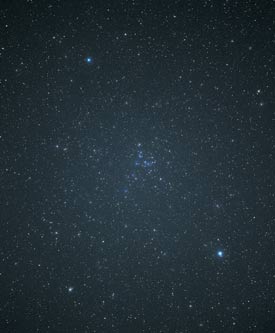
Tuesday, March 20
• Today is the equinox. At 12:15 p.m. EDT the center of the Sun crosses the equator — both Earth's equator and the celestial equator, which Earth's equator defines. This moment marks the beginning of spring in the Northern Hemisphere, fall in the Southern Hemisphere.
And no, eggs don't balance better today than at any other time!
• After dark Leo strides up the eastern sky, with his brightest star Regulus in his forefoot and the Sickle of Leo extending upper left from there.
About two fists lower left of Regulus are the two stars of Leo's rear end and tail: Delta Leonis (magnitude 2.5) and, below it, slightly brighter Beta Leonis, or Denebola, the tail tip (magnitude 2.1).
As evening grows late and this scene rises higher, look left of Denebola, by a fist or a little bit more, for the big, dim Coma Berenices star cluster. Its brightest members form an upside-down, tilted Y. It's visible even through some light pollution. If you can't see it naked-eye, binoculars reveal it well, looking rather ragged and more or less filling the field of view.
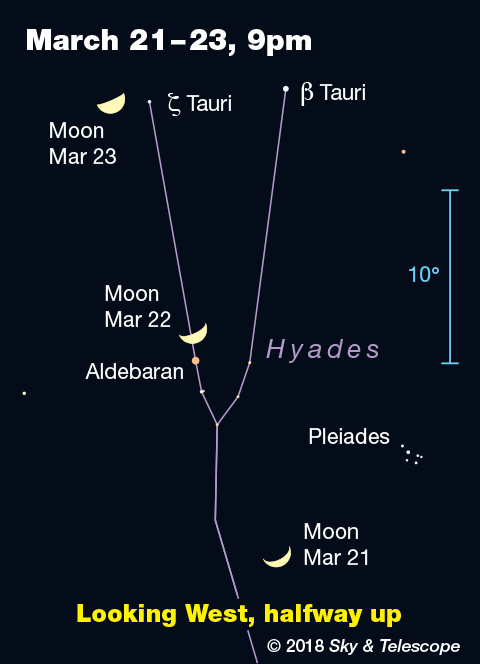
Wednesday, March 21
• Upper right of the crescent Moon this evening, you'll find the Pleiades. Upper left of the Moon are Aldebaran and the Hyades.
• Do you know how to find the horntips of Taurus, Zeta (ζ) and Beta (β) Tauri? One way is to extend the sides of the Hyades V way up, by about a fist and a half, as shown here. (The Moon will join them in two days.)
But another way uses brighter stars. Spot Betelgeuse high in the southwest these evenings. It's Orion's topmost bright star. Then look high in the northwest for Capella, even brighter. The horntips of Taurus lie halfway between them, lined up with them. Beta, on the right, is the brighter of the two.
Thursday, March 22
• Aldebaran pairs closely with the Moon this evening.
• Castor and Pollux shine together nearly overhead in the south after dark. Pollux is slightly the brighter of these "twins." Draw a line from Castor through Pollux, follow it farther out by a big 26° (about 2½ fist-widths at arm's length), and you're at the dim head of Hydra, the Sea Serpent. In a dark sky it's a subtle but distinctive star grouping, about the size of your thumb at arm's length. Binoculars show it easily through light pollution or moonlight.
Continue the line farther by another fist and a half and you hit Alphard, Hydra's orange heart.
Another way to find the head of Hydra: It's almost midway from Procyon to Regulus.
Friday, March 23
• The Moon joins the lineup of Betelgeuse, the Taurus horntips, and Capella. See Wednesday above.
• Now that it's spring, the signature fall-and-winter constellation Cassiopeia is retreating downward after dark. But for skywatchers at mid-northern latitudes Cassiopeia is circumpolar, never going away completely. Look for it fairly low in the north-northwest these evenings. It's still standing nearly on end.
Saturday, March 24
• First-quarter Moon (exact at 11:35 a.m. EDT). This evening the Moon shines high above Orion, in the feet of Gemini below Castor and Pollux.
________________________
Want to become a better astronomer? Learn your way around the constellations! They're the key to locating everything fainter and deeper to hunt with binoculars or a telescope.
This is an outdoor nature hobby. For an easy-to-use constellation guide covering the whole evening sky, use the big monthly map in the center of each issue of Sky & Telescope, the essential guide to astronomy.

Once you get a telescope, to put it to good use you'll need a detailed, large-scale sky atlas (set of charts). The basic standard is the Pocket Sky Atlas (in either the original or Jumbo Edition), which shows stars to magnitude 7.6.
Next up is the larger and deeper Sky Atlas 2000.0, plotting stars to magnitude 8.5; nearly three times as many. The next up, once you know your way around, is the even larger Uranometria 2000.0 (stars to magnitude 9.75). And read how to use sky charts with a telescope.
You'll also want a good deep-sky guidebook, such as Sue French's Deep-Sky Wonders collection (which includes its own charts), Sky Atlas 2000.0 Companion by Strong and Sinnott, or the bigger Night Sky Observer's Guide by Kepple and Sanner.
Can a computerized telescope replace charts? Not for beginners, I don't think, and not on mounts and tripods that are less than top-quality mechanically (meaning heavy and expensive). And as Terence Dickinson and Alan Dyer say in their Backyard Astronomer's Guide, "A full appreciation of the universe cannot come without developing the skills to find things in the sky and understanding how the sky works. This knowledge comes only by spending time under the stars with star maps in hand."
This Week's Planet Roundup
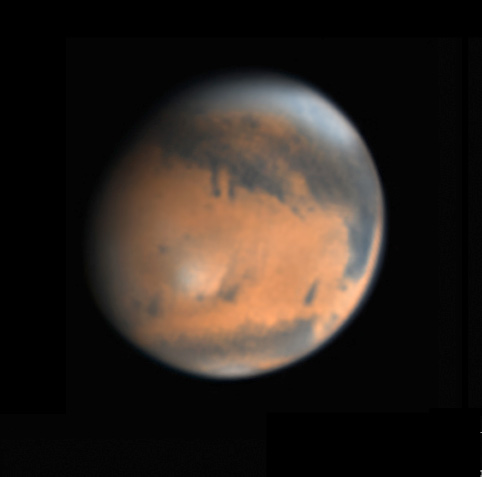
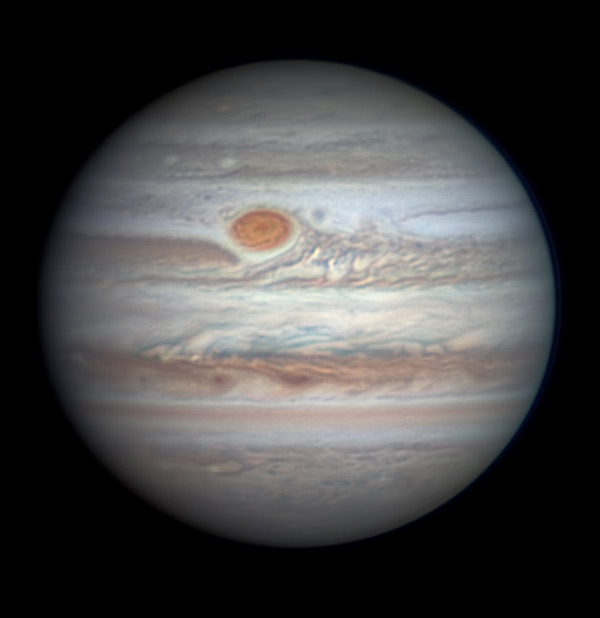
Find Mercury and Venus low in evening twilight, due west. Venus shines at magnitude –4, while little Mercury fades rapidly from magnitude 0 to +2 this week. Look for Mercury upper right of Venus early in the week, right of it by about March 19th or 20th (depending on your latitude), and lower right of it toward week's end. They remain about 4° apart through the 22nd.
Mars and Saturn, together in Sagittarius, rise around 3 a.m. daylight-saving time. At the beginning of dawn they're the brightest points moderately low in the south-southeast, above the fainter Sagittarius Teapot. They're equally bright at magnitude +0.5, but Mars is redder. Far to their right at that time is Antares, and farther right is bright Jupiter.
Mars continues drawing closer to Saturn as seen from Earth's moving point of view. They appear 8½° apart on the morning of March 17th and 5° apart by the 24th. They'll pass each other by 1.3° on April 2nd.
Jupiter (magnitude –2.3, in Libra) rises around 11 or midnight daylight-saving time and shines as the brightest point in the early-morning sky. Jupiter is highest and presents the sharpest views in a telescopes around 4 or 5 a.m., well before dawn.
Uranus and Neptune are behind the glare of the Sun.
______________________
All descriptions that relate to your horizon — including the words up, down, right, and left — are written for the world's mid-northern latitudes. Descriptions that also depend on longitude (mainly Moon positions) are for North America.
Eastern Daylight Time (EDT) is Universal Time (also called UT, UTC, GMT, or Z time) minus 4 hours.
______________________
"Remember to look up at the stars and not down at your feet. Try to make sense of what you see and wonder about what makes the universe exist. Be curious."
— Stephen Hawking, 1942–2018
______________________
"The dangers of not thinking clearly are much greater now than ever before. It's not that there's something new in our way of thinking, it's that credulous and confused thinking can be much more lethal in ways it was never before."
— Carl Sagan, 1996
______________________
"Objective reality exists. Facts are often determinable. Vaccines save lives. Carbon dioxide warms the globe. Bacteria evolve to thwart antibiotics, because evolution. Science and reason are not a liberal conspiracy. They are how we determine facts. Civilization's survival depends on our ability, and willingness, to do so."
— Alan MacRobert, your Sky at a Glance editor
______________________
"Facts are stubborn things."
— John Adams, 1770
 2
2








Comments
greg webb
March 22, 2018 at 10:44 am
Mr. MacRobert. Our small community is applying for official night sky community the IDA. Believe it or not just 28 miles from Austin, TX, we still have the milky way on many nights. As a tool to help us bring awareness to the night sky, we would love to be able to publish your map in our weekly newspaper--not the entire week but just the one map with comments. Is there a way we can get permission to use your materials. Thanks so much---Greg Webb
You must be logged in to post a comment.
mary beth
March 22, 2018 at 11:57 pm
The pairing of the moon and Aldebaran tonight was so pretty! We had beautiful, crystal clear skies tonight in Houston. Happy Spring to all!
You must be logged in to post a comment.
You must be logged in to post a comment.